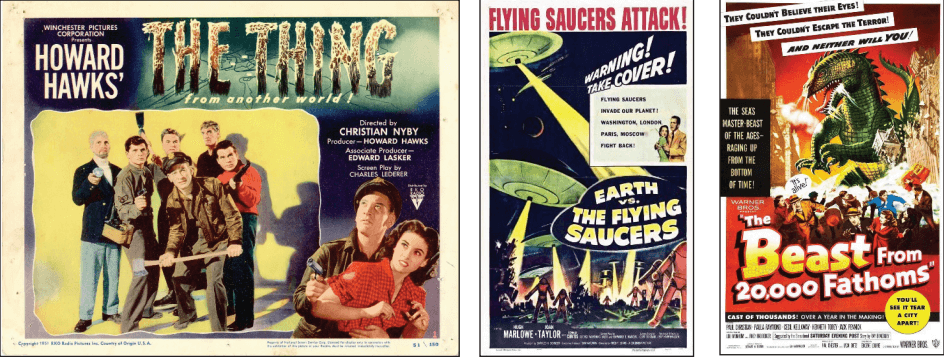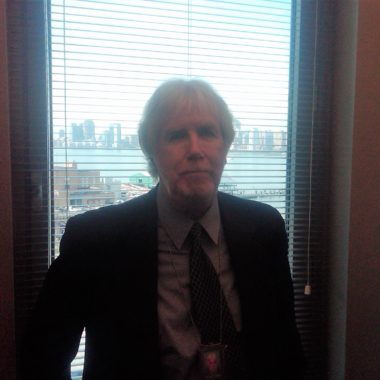UFOs are much in the news lately, rebranded by the Pentagon as UAPs (Unidentified Aerial Phenomena), but I learned all about them early in life, thanks to Hollywood…and a rather odd neighbor.
In the Flatbush of my youth, a movie theater sat across the street from our house, The Farragut. On many a Saturday morning, equipped with a quarter for admission and a peanut butter & jelly sandwich for lunch, the kids on my block would line up well before the box office lady opened her window at 11:30AM. Once inside, the rich kids would get popcorn and candy while us mutts would rush past the white-uniformed matron to grab the best seats in the far left area labeled, “The Children’s Section.” The kiddie extravaganza would then ensue: a cartoon, a newsreel, and a double feature. The movies we wanted to see had to feature cowboys, soldiers, monsters or Martians. But only a few of the westerns were memorable, Shane especially, because of the child character, Joey, who idolized the gunslinger-trying-to turn-the-page, Shane (when it ended, we all burst out onto Flatbush Avenue warbling Joey’s famous plea, “Shane! Come back!”)
The only war movie I remember resulted in me and three of my siblings getting thrown out and banned from the Farragut. It was The Bridges at Toko Ri, starring William Holden and some blonde (whenever she appeared, we knew there’d be no action so we took bathroom breaks or ogled the candy counter). The drama ended with most of the male cast biting the dust. Frederick Marsh, playing an admiral, upon learning their fate, stares off into the distance from the bridge of his carrier and utters the solemn closing line: “Where do we find men such as these?” At that point my sister Mary rose up out of her seat to answer the admiral by bellowing in her finest Brooklyn accent, “IN HOLLYWOOD, WHERE ELSE, YA JERK!” Marched to the manager’s office by the matron, a man in a suit vowed we would never enter his hallowed theater again BY GAWD! But since face recognition technology would not be invented for another 60-odd years, we kept going to the Farragut on Saturdays.
Our favorite genre, by a wide margin, was science fiction in all its flavors: 1) prehistoric behemoths encased in the deep sea or Artic ice, revived by darned nuclear bomb tests, who then inevitably find their way to Tokyo (Godzilla), San Francisco (It Came From Beneath the Sea), or New York (The Beast from 20,000 Fathoms); 2) ordinary organisms transformed by nukes, aliens or careless scientists (ants in Them!, a tarantula in Tarantula!, and humans in Attack of the 50 Foot Woman and The Incredible Shrinking Man); and 3) aliens from outer space (Earth vs. The Flying Saucers, It Came from Outer Space, Not of This Earth, etc. Of course, some films mixed and matched these categories. For instance, The Thing was an alien monster who was thawed from Artic ice.
Most of these movies adhered to a predictable structure. In the first half hour, a mysterious deadly but unseen thingie causes havoc, followed by 30 minutes of escalating carnage as the thingie shows up in some urban center. At that point, stock World War II military footage is spliced in as our armed forces bomb the hell out of the thingie, all to no avail. This leads to the denouement, when the hero, usually the love interest of a female relative of some scientist or general, goes mano-a-mano with the bad thingie and Earth survives until the next movie.
Strangely, Earth vs. The Flying Saucers was based on a non-fiction book, Flying Saucers from Outer Space, by retired Marine Major Donald Keyhoe who also served as a “technical consultant.” A few years later the Science Fiction Book Club offered a free book if you signed up, so I selected a book by Keyhoe, Flying Saucers Top Secret. It read like an action thriller, with brave government agents leaking info to Keyhoe as other sinister agents try to silence everybody, all of which is delivered in breathless conversations wherein incredible hidden events and possible earth-shattering developments are suggested. I was hooked, and I guess I still am
Meanwhile in the middle of our block, there resided a man whose information about aliens went way beyond Keyhoe’s “leaks.” Mr. Steele (nobody knew his first name) looked exactly like the truant officer, Mr. McNabbem, in the Little Lulu comics, complete with a Hitler-esque mustache and a bowler hat. Except, unlike McNabbem, Mr. Steele would urinate against trees and frequently walk around bare-chested, wearing a knotted tie to emphasize the fact. It was said his father had been ambassador to some Eastern European country who left his son a monthly stipend in perpetuity. Of most interest, however, Steele was receiving messages from space aliens and my oldest brother, Buddy, a copy boy for the New York Times who conducted tours for visitors, would regale us with stories of Mr. Steele showing up in the lobby of the Times building, demanding to speak to reporters about the aliens’ latest dire transmissions.
Prompted in part by his interactions with Times’ visitors getting radio beams from wire coat hangers they had wrapped around their foreheads, Buddy came to share my interest in UFOs. It seemed to me (being a Keyhoe convert), there had been many unexplained sightings. Buddy, who served some time in the American southwest for the Army, joked about being mobilized to fight the alien menace and winding up in the stock footage for Earth vs. The Flying Saucers, Part Deux. But more than anything else, I think we savored the bizarre tales told by the “contactees” getting phone calls from outer space because they took us far, far away from hardscrabble Rogers Avenue and the dull daily drudge of city life.
Buddy died in my arms in 1979 as I was helping him to his bed, his body wracked with cancer. A couple of months later, I was in a motel out in the Hamptons where I dreamed that he was waving to me from a UFO. In the dream, my brother was very happy, telling me that our spirits did survive death, the universe was wonderful and we would see each other again. It was a very vivid dream and it ended with his telling me to go to the balcony of my motel room. I woke up and walked to the balcony and slid open the glass door. It was a beautiful, clear night. I looked up, and there, streaking across the sky, was a shooting star.
To quote the last line of The Thing, “Keep watching the skies!”










